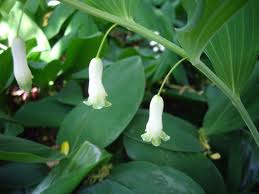Polygonatum
These perennials, commonly known as Solomon's Seal, are mainly natives to North America and various parts of Europe. P. hirtum grows up to 3 feet high with a 1-foot spread. Its lance- to oval-shaped, fresh green leaves are arranged alternately on the stems. The leaves, stems and leaf stalks are slightly fuzzy. In late spring, arching stems carrying drooping clusters of small, tubular flowers are produced. The flowers are white tipped with green. P. hybridum grows up to 4 feet high and has bright green, oval leaves, which clasp the stem. The arching stems of drooping, greenish-white flowers are borne in late spring. These plants are nice to group in open spaces among trees, towards the front of shrubbery, or in an informal part of the garden. It isn't suitable for the herbaceous border because they are vigorous and the roots spread quickly. It shouldn't be placed near special plants for it may become troublesome.
Pot Cultivation
Solomon's Seal may be planted in any good, moderately fertile soil that will stay moist, but not waterlogged. Choose a shady location. The leaves of P. hybridum may be susceptible to damage by sawfly larvae. These plants look good in pots. Pieces of rooted sections should be potted in the fall in 6- or 7-inch pots filled with loamy soil. Keep the soil slightly moist throughout the winter.
Propagation
Seeds or division in the spring is used to increase these plants.
 |
 |
P. biflorum |
P. commutatum |
VARIETIES
- P. hybridum;
- P. hirtum;
- P. multiflorum;
- P. pubescens;
- P. biflorum;
- P. commutatum;
- P. japonicum;
- P. officinale;
- P. roseum;
- P. verticillatum.






